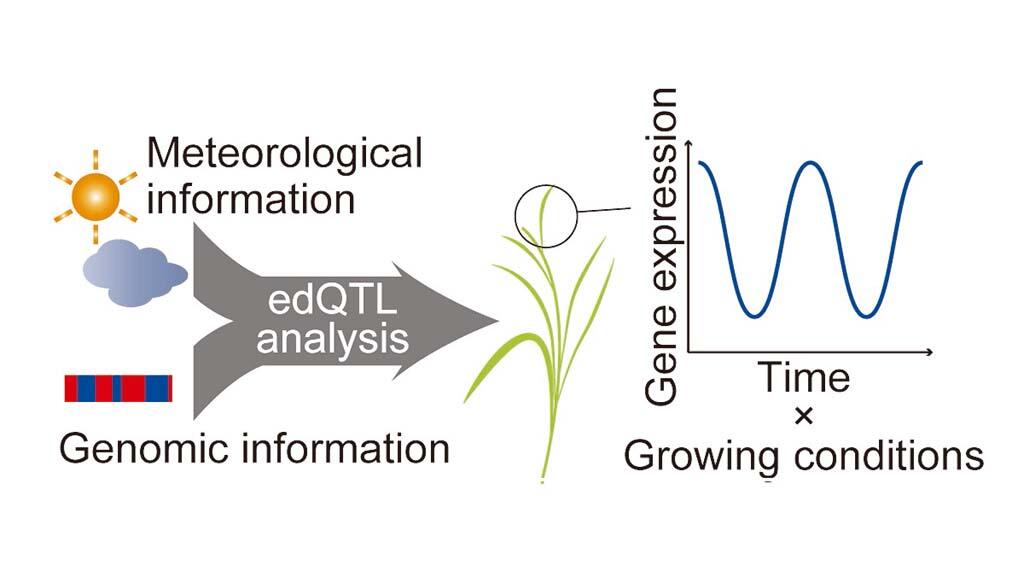A research group, which consisted of members from Tokyo University of Agriculture and Technology, Kyoto University, Aoyama Gakuin University, Shiga University, Keio University, and Saibi High School, was headed by Associate Professor Atsushi J. Nagano (Ryukoku University; Faulty of Agriculture) and Research Fellow Makoto Kashima (Ryukoku University; Research Institute for Food and Agriculture) and successfully developed a technology that makes it possible to predict the response of genes in various rice strains using meteorological information.
Even for the same cultivar with the same genomic sequence, the yield and quality vary greatly depending on the environment. This is because the genes that are activated and their expression level in crops change depending based on environmental factors. As a result, regional and annual differences occur. According to Associate Professor Nagano, "We hoped that the research would fill the gap between laboratory studies on gene functions and actual field studies on breeding and cultivation."
The researchers focused on the most widely cultivated cultivar in Japan "Koshihikari" and the high-yielding variety "Takanari." They developed a method that predicts the environmental responses of the progeny line--produced by crossbreeding between the parental cultivars--at the gene expression level. This progeny lineage is called the chromosome segment substitution line (CSSL). Most of the genome matches the parent lineages Koshihikari or Takanari. However, only a part of the chromosome is replaced by the other parent line. By examining chromosomal markers, each genomic region can be distinguished into the Koshihikari type or Takanari type.
In 2015, a total of 80 strains of Koshihikari, Takanari, and CSSL were cultivated at the farm of the Graduate School of Agriculture, Kyoto University; 24 h sampling every 2 h was performed multiple times throughout the cultivation season. RNA was extracted from the leaves of each rice plant, coming to a total of 845 samples; the expression levels of all genes were comprehensively measured using RNA-Sequencing (RNA-Seq). Next, the data on the temperature and solar radiation at the time of sampling obtained from AMeDAS and those on the total gene expression level were analyzed using the FIT analysis program.
The group created an environmental response model that predicts the gene expression levels of Koshihikari and Takanari in any environment. The findings clarified that 3696 genes displayed different environmental responsiveness between Koshihikari and Takanari. In addition, a causative region (edQTL), containing polymorphisms in the genomic sequence responsible for different environmental responsiveness between Koshihikari and Takanari, was identified for 1675 genes by statistically verifying the relationship between the region replaced from the parent line by CSSL and the differences in the expression level of each gene of the parent line (Koshihikari and Takanari) predicted using the environmental response model and the measured value of each sample. Furthermore, the researchers verified whether it is possible to actually predict the environmental response based on the identified edQTL information.

Credit: Ryukoku University, Aoyama Gakuin university
The predicted value in the environmental response model of the background parent strain without considering edQTL, the predicted value considering edQTL, and the measured value by RNA-Seq were compared. The results clarified that the prediction accuracy of gene expression was improved and the environmental response in different cultivation environments can be predicted by considering edQTL.
The predicted value in the environmental response model of the background parent strain without considering edQTL, the predicted value considering edQTL, and the measured value by RNA-Seq were compared. The results clarified that the prediction accuracy of gene expression was improved and the environmental response in different cultivation environments can be predicted by considering edQTL. It was also confirmed that the backcross recombinant inbred line (BIL), which has a more complicated genomic region replacement than the CSSL used for edQTL identification, can accurately predict the differences in environmental responses. Associate Professor Nagano said, "We would like to predict gene expression more accurately for additional strains in the future. By advancing research to enable prediction of various traits from gene expression, we hope to develop a technology for designing genome composition necessary to realize a specific trait in a given environment."
The original journal article can be read at the following link:
https://academic.oup.com/pcp/advance-article/doi/10.1093/pcp/pcab088/6300028
This article has been translated by JST with permission from The Science News Ltd.(https://sci-news.co.jp/). Unauthorized reproduction of the article and photographs is prohibited.




